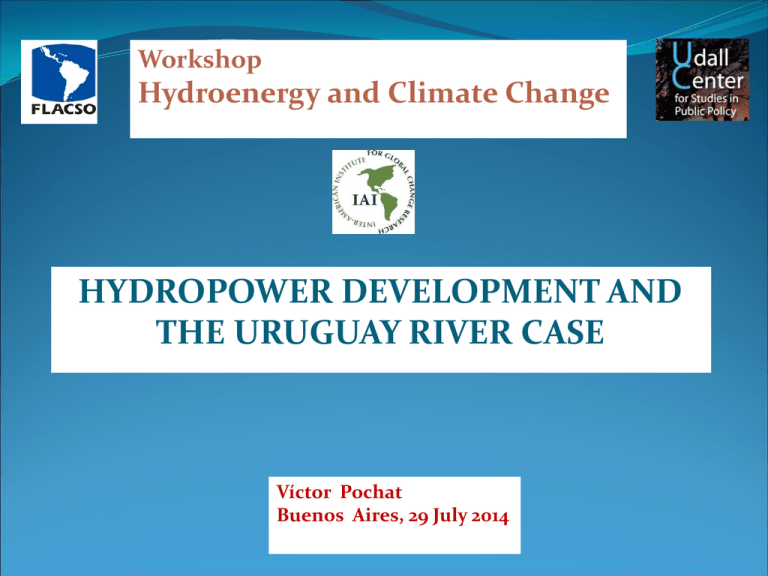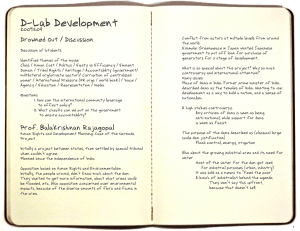HYDROPOWER DEVELOPMENT AND THE URUGUAY RIVER CASE Hydroenergy and Climate Change Workshop
advertisement

Workshop Hydroenergy and Climate Change HYDROPOWER DEVELOPMENT AND THE URUGUAY RIVER CASE Víctor Pochat Buenos Aires, 29 July 2014 URUGUAY RIVER BASIN Area 365,000 km2 LA PLATA BASIN 3.1 M km2 URUGUAY RIVER Length 1,850 km Mean annual flow 4,500 m3/s URUGUAY RIVER BASIN DAMS UNDER OPERATION Countries BRAZIL Foz do Chapecó Rincón del Bonete URUGUAY ARGENTINAURUGUAY Salto Grande Rivers Uruguay Dams Itá Capacity (Mw) 1,450 Foz do Chapecó 855 Canoas Campos Novos 880 Pelotas Barra Grande 708 Passo Fundo Passo Fundo 226 Chapecó Quebra-Queixo 121 Machadinho Pelotas Negro Rincón del Bonete 160 Baygorria 108 Palmar 333 Uruguay Salto Grande 1,140 1,890 WORLD DECLARATION WATER STORAGE FOR SUSTAINABLE DEVELOPMENT(Kyoto, 2012) The global increase in population and the socio-economic development with increasing living standards for all, will continuously raise the requirement for water, food and energy consumption. Due to climate change, water distribution may become more irregular, and disasters related to floods and droughts will worsen. WORLD DECLARATION WATER STORAGE FOR SUSTAINABLE DEVELOPMENT(Kyoto, 2012) Energy sources are limited: Fossil energies are polluting and emitting greenhouse gases and their reserves are limited; Nuclear energy is restricted to industrial countries which have the technology and the security of nuclear energy has aroused people's wide concern; Variable renewables such as wind and solar sources are valuable and should be developed as much as possible; however, they need back up. Hydropower can play this role. WORLD DECLARATION WATER STORAGE FOR SUSTAINABLE DEVELOPMENT(Kyoto, 2012) To face this century’s greatest challenge – to manage water sustainably –we need to strengthen existing water systems and further develop new water storage infrastructure. This will require adequate legislation and funding. It must also include the optimization of the use of water by combining multiple purposes: flood management and drought mitigation, irrigation for food production, energy production, drinking water and sanitation, industrial water supply, navigation, environmental services, etc. ENVIRONMENTAL AND SOCIAL CONCERNS UNITED NATIONS ENVIRONMENT PROGRAMME DAMS AND DEVELOPMENT PROJECT The role of dams is considered in the context of sustainable development. This involves dealing not only with environmental and social issues but also economic aspects associated with the benefits of dams. A narrower perspective, focusing only on negative social and environmental impacts, leads invariably to polarizing the debate on whether dams should be built or not. When the full range of social, environmental and economic issues is considered, dams become a valid option and the question changes to how to build a good dam. UNITED NATIONS ENVIRONMENT PROGRAMME DAMS AND DEVELOPMENT PROJECT Sustainability of dams involves consideration of the engineering, environmental, social, economic and financial aspects within the context of an informed and participatory decision-making process. This integrated approach also includes dealing with the entire basin when planning, developing and managing water resources, recognizing upstream and downstream interlinkages and being aware of particular stakeholder interests and areas of potential conflict. Source: United Nations Environment Programme, Dams and Development. Relevant practices for improved decision-making, available at www.unep.org/dams Workshop Hydroenergy and Climate Change THANK YOU VERY MUCH Víctor Pochat vpochatm@yahoo.com.ar





